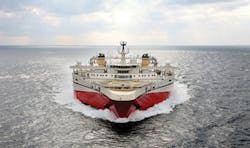GEOSCIENCES
OCS permits spark debate
Seismic permitting and exploration off the US Atlantic margin has re-entered the news recently, as law-makers on the state and local levels have been making their respective cases to officials including President Barack Obama himself.
In June, US Representatives Mark Sanford (R-SC) and Gerry Connolly (D-VA) joined in sending a letter signed by 53 other representatives to Obama requesting a halt to the permitting process for potential seismic testing in the Atlantic Ocean.
The US Department of the Interior and the US Bureau of Ocean Energy Management’s (BOEM) proposed outer continental shelf (OCS) oil and gas leasing program for 2017-2022 excluded the Atlantic coast after a portion was previously included in a draft. Despite this, permits to acquire new seismic data within the Atlantic OCS are still sitting with the BOEM following its July 2014 record of decision clearing the way for G&G survey activities.
“[I]t makes little sense to conduct seismic testing off the Atlantic coast, when the Atlantic Ocean has been excluded as a possible site for offshore drilling by the Department of Interior,” Sanford said in a statement. Sanford and Connolly were both adamant that the respective coastal communities they represent were opposed to seismic activity, which is consistent with an earlier announcement from US Secretary of the Interior Sally Jewell.
Less than a week after the representatives’ letter reached 1600 Pennsylvania Ave., North Carolina Governor Pat McCrory wrote Jewell to stump for the inclusion of the Atlantic in the final version of the OCS lease sale. In it, he closed by urging the government to move forward with reviewing the permits.
“I urge the US Department of the Interior and other federal agencies to promptly complete the review of four pending applications requesting approval to conduct geophysical surveys in the Atlantic,” McCrory said in the letter to Jewell.
The North Carolina lawmaker also protested the practice of basing resource decisions on outdated data - data that the BOEM identified in the proposed plan as being more than 40 years old.
“New exploration using modern 2D and 3D seismic techniques will provide policy makers and industry more accurate resource estimates from which they can make informed decisions about the mid-Atlantic OCS. Existing estimates are based on decades-old technology and do not effectively quantify or pinpoint potential resources. New data will ensure economically and environmentally sound activity should future development take place,” McCrory wrote.
In 2014, the BOEM estimated 4.72 Bbbl of undiscovered technically recoverable oil and a mean of 37.51 tcf of undiscovered technically recoverable natural gas in the Atlantic OCS.
NOIA, others respond
In response to the letter to Obama, president of the National Ocean Industries Association Randall Luthi toldOffshore: “The letter is not based on science or practice. The fact is that seismic surveys have been conducted safely in the world’s oceans for many decades, not only to search for oil and natural gas, but also to locate underwater structures, discover shipwrecks and to determine suitable sites for offshore wind turbines.
“I doubt that most of those calling for a ban on seismic surveying have ever been onboard a seismic vessel to witness first-hand survey operations which include stringent measures to avoid and mitigate environmental impacts, such as the required gradual ramping up of sound levels and the required presence of trained marine mammal observers who scan the survey area so that operations can be halted if marine mammals are seen nearby,” he continued.
“Seismic surveys are not new to the Atlantic OCS; they have been conducted periodically over the past 50 years with no reported injuries or significant disturbances to marine life. Seismic research ensures future decisions on leasing and drilling are well-informed and not made blindly.”
NOIA is not alone in its opposition. The International Association of Geophysical Contractors, API, and others have also urged the bureau to act on the permits.
Like McCrory, IAGC COO and Executive Vice President Walt Rosenbusch decried the age of the data: “The US Atlantic OCS has been excluded from the five-year planning process for several decades - based in large part on the position that the resource potential was not significant. … Had the administration moved forward - granting the authorizations to acquire new seismic data - they would have data that would better define the resource potential on the Atlantic OCS.”
Earlier this year, the API pointed to a number of US officials that were on the record as supporting the inclusion of the Atlantic OCS. Along with McCrory, these included Senator Marco Rubio of Florida, Senator David Perdue of Georgia, Senator Tim Scott of South Carolina, and Senator Mark Warner of Virginia.


